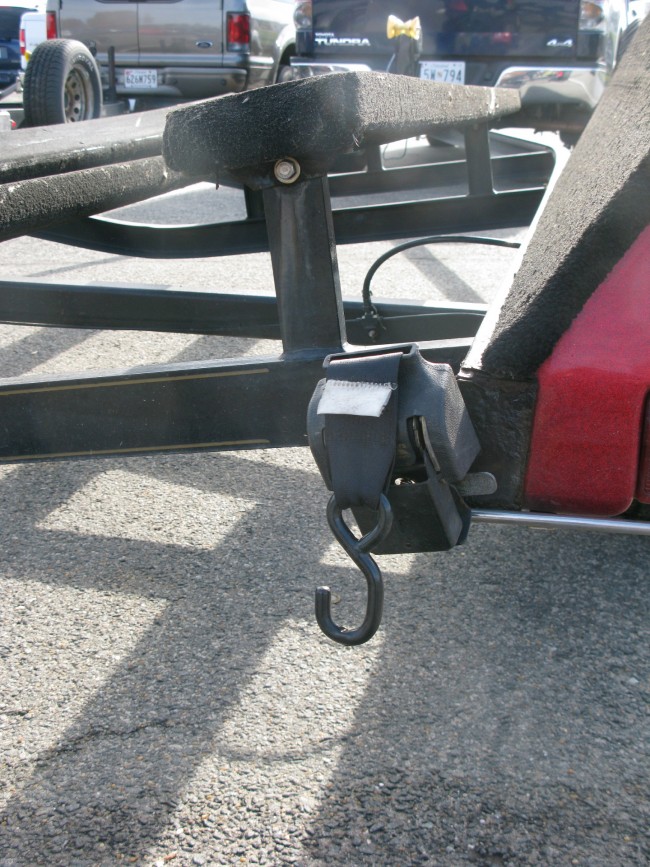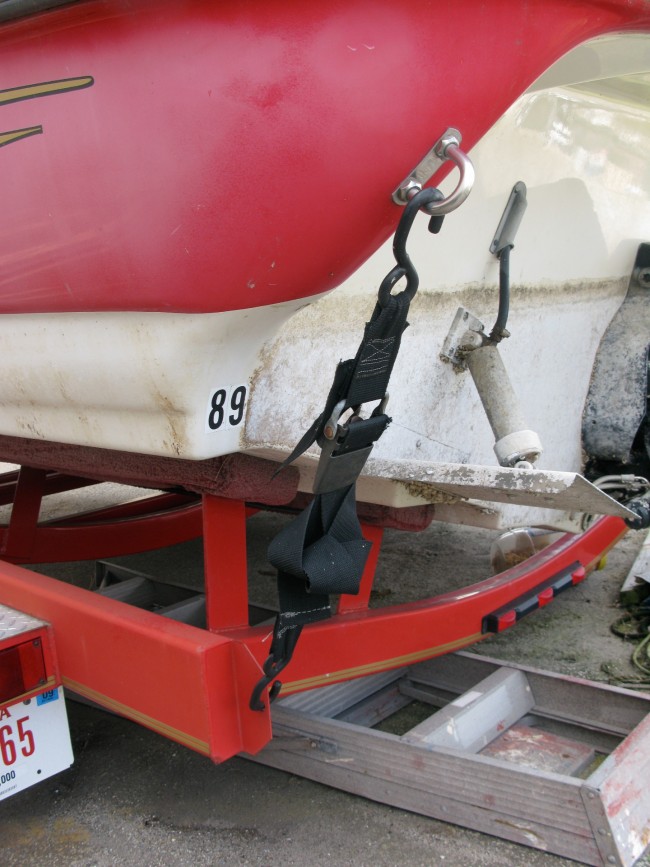
When you think about it, keeping the boat on the trailer is the whole idea
At first glance it seems logical to do everything possible to secure your boat to the trailer. After all, you want to launch it on the water, not on the road to the water. As it stands right now, your boat is secured to its trailer with a safety chain/strap combination that attaches to the bow eye and transom tie-downs that fasten the hull to the trailer. In many states, this is the law.
But tie-downs across the middle (gunwale) of the boat? Well, that's a whole 'nother matter.

"Florida law does not specifically state that gunwale tie-downs are required," says Captain Mark Brown of the Department of Highway Safety and Motor Vehicles. "We do require all trailers to be securely fastened to a vehicle and have safety chains and cables, and that the boat is secure on the trailer (Florida statute 316.250). Gunwale tie-downs are a personal decision by the boat owner in Florida."
"The strap over the boat is a better arrangement," notes Tony Dippolito of Magic Tilt trailers about gunwale tie-downs. "But it can cause cosmetic damage to the gelcoat, and thus more people are using the transom tie-downs."
That is the most common reason boaters shy away from the idea, despite the fact that a gunwale tie-down will provide one more layer of securing the boat to the trailer. Even though the strap has the potential to rub against the gelcoat while the trailer is on the road, many boaters counter the problem by placing specially designed pads between the tie-down and the hull, or save their money and rely on old carpeting. The pads are usually three inches wide and designed to easily slide onto the tie-down strap.

And that presents another problem: Many boat trailers aren't built with specific points (also called mounting tabs) where the gunwale strap can be attached to the frame. While there usually are holes to accommodate transom straps, it's rarely done for tie-downs designed for gunwales. Most tie-down attachments have either an "S" hook or a "J" hook that can be "hooked" onto the trailer frame and then tightened with either a ratchet or a buckle.
West Marine Senior Category Manager David Ungerecht has seen this all too often. "Some boats do not come with transom eyes for attachment, so only a gunwale tie-down is used. On boats that hang too far past the end of the trailer, making transom tie-downs tough to use and not real effective for up/down stoppage of movement, gunwale tie-downs are the only solution. So I think it's cheap insurance. Gunwale tie-downs are more effective in keeping the boat affixed to the trailer."
Tony Dippolito of Magic Tilt also likes the use of the extra tie-down across the gunwale. "I like the strap over the boat as I believe it keeps the boat more secure to the trailer. This keeps the boat from jumping up off the bunks of the trailer when hitting bumps and then the impact of returning to the trailer doing damage to the boat and the trailer."

Now About Those "Other" Tie-Downs
Securing the boat at the transom and the bow has to be done prior to using gunwale tie-downs. The reason? To do otherwise means moving the hull back and forth while the gunwale tie-down is already in place. If there's ever a chance of damaging the hull, this will do it. But here's the thing: Some folks will attach their boat at the bow and not follow through. "If the winch and bow stop are properly set up with the bow eye under the roller, you'll have control of the boat in a vertical direction," notes Magic Tilt's Dippolito. "Many people load their boat and do not tighten the boat to the bow eye once it has been pulled out of the water. This, then, allows the boat to move in a vertical direction at the bow. With an aluminum trailer, this also allows the trailer to flex and the boat bounce while driving down the road. After a period of time with the trailer flexing, it allows the I-beams to crack at the bend."
Rick Norman of EZ Loader Trailers agrees and says securing to the winch post isn't the only step to take. "You need a winch strap with bow-eye safety chain on the front of the boat," he says. "And either a transom- or gunwale-style on the stern. Very few people do both."
Tie-Down Need-To-Knows
Tie-downs are available in a variety of lengths. Obviously the transom tie-down is usually no longer than four feet while a gunwale tie-down, which reaches from the bottom of the trailer across the boat and back down to the trailer frame, is available in lengths from 13 feet to as long as 20 feet. In most uses, two tie-downs are connected to each other to accommodate a boat's beam. In fact, most tie-downs are sold in pairs.
Whether you use a buckle or a ratchet to tighten the tie-down to the boat, be sure to check the setup after a half-hour or so on the road. Depending on the terrain, a boat can shift and settle on the trailer, which can loosen the tie-down's grip on the hull.
Tie-downs sold at West Marine are made by CORE, and company spokesman James Collins has this advice when making a selection: "When a boat is sitting on a trailer, there is theoretically no load on the tie-downs. What we're trying to do is keep the boat on the trailer when it's going down the road, over bumps, and up and down inclines. We're not hanging or lifting the boat so, provided we can keep the boat securely attached to the trailer and not moving with respect to each other, the load on the tie-downs isn't huge."












